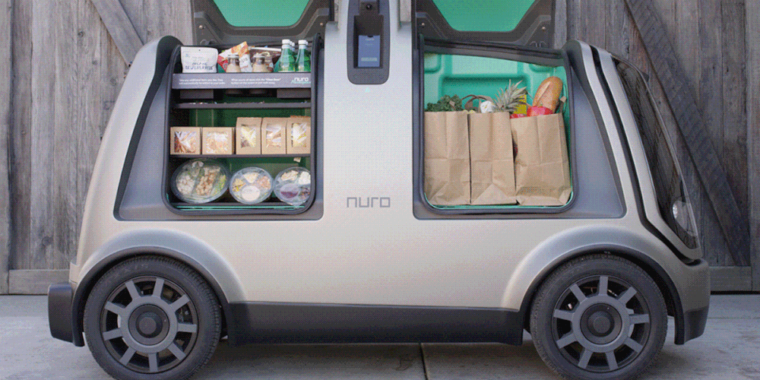
Nuro
Until this week, the federal government’s automotive safety regulations were based on two assumptions that probably seemed evident when they were written: that every car will have people inside and one of those people will be the driver. To protect the safety of the driver and potential passengers, the Federal Motor Vehicle Safety Standard (FMVSS) requires that all cars have seat belts and airbags. It also sets minimum standards for everything from windshield strength to crash test performance.
In the coming years, these assumptions will become increasingly out of date. Then, on Thursday, when the Trump administration is coming to an end, the National Highway Traffic Safety Administration (NHTSA) published a new version of the FMVSS that recognizes that some cars have no drivers – and some vehicles have no one at all.
One of the biggest beneficiaries of these new rules will be Nuro, a startup that is building delivery robots designed to operate on the streets instead of on the sidewalks. In a statement to Ars, Nuro hailed the rules as “a significant advance that will help Nuro to market our autonomous delivery vehicles”.
A series of FMVSS rules are designed to protect the occupants of a vehicle – for example, rules that require airbags and seat belts. Nuro points out that these requirements are worse than useless for a delivery vehicle without passengers. In a collision, the added weight of unnecessary equipment increases the chances of injury to people outside the vehicle.
Last year, Nuro asked NHTSA for special exemptions from some of these rules – including allowing Nuro’s robots to have no windshields. In its new rule, NHTSA offered this exemption to anyone building a vehicle designed for zero passengers. NHTSA waived requirements for seat belts and airbags, as well as rules on the design of door and seat locks. It also exempts these vehicles from meeting accident resistance standards, as the vehicles will only have pizza or groceries inside – not humans.
No more “driver’s seat”

Even when a vehicle is designed to transport people, it will not necessarily have a driver. Some autonomous vehicles will be “dual mode” vehicles, in which the driver has the option of taking control and driving with conventional controls. But others may not have a steering wheel or pedals. And that would conflict with the old rules, which assumed that every car would have a driver in the left front seat.
The new rules clean up a lot of terminology. Instead of referring to the “driver’s side” and “passenger side” of the car, the new rules only refer to the left and right sides. If the vehicle does not have a driver’s seat, the rules for the right front seat (the “passenger seat”) also apply to the left front seat.
If a car has both autonomous and manual driving capabilities, it must be able to detect when there is a child in the driver’s seat and disable autonomous driving capabilities.
The new rules also recognize that the design of vehicle controls can change over time. The phrase “steering wheel” was used in many places in the old rule. NHTSA made a search and substitution in favor of “steering control”, which makes it clear that a steering wheel does not have to be circular.
At the same time, NHTSA rejected Tesla’s request to make rules about alternative methods of controlling a vehicle. In a regulatory document last year, the automaker predicted that automakers could develop “new concepts that depend on buttons, joysticks, screens, etc.” In the future, a car may not have a single driver. Instead, multiple passengers may have the ability to control a vehicle from different seating positions. Thus, Tesla urged NHTSA to completely dispense with the concept of the driver’s seat. NHTSA rejected this approach.
“The new definition is intended to cover traditional steering controls, not future controls that have not yet been developed,” wrote the agency in response. “This regulation does not address joystick designs that are intended to be the only manual steering control, or steering controls that do not have a fixed position in a particular seating location.”
Automotive safety group wants NHTSA to do more
NHTSA has taken an important step to streamline the development of autonomous vehicles. But even more important is what the agency chose not to do this week: has not created any significant new regulations on testing or deploying autonomous driving technology.
Autonomous vehicles are almost completely deregulated by federal law. As long as a company starts with an FMVSS compliant vehicle, federal law gives you free rein to convert it into an autonomous car and test it on public roads. NHTSA hardly exercised formal oversight over these testing efforts.
For example, companies that test self-driving cars in California must send annual reports to state regulators, detailing the number of miles they have driven and the types of accidents that have occurred. Federal regulators did not impose such a requirement.
Advanced driver assistance systems (ADAS) also lack real federal oversight. Federal law does not impose minimum performance standards for these systems, does not impose standardized interfaces for them, and does not require the use of driver monitoring systems to ensure that drivers monitor them properly while they are active.
Therefore, the Trump administration’s focus on reviewing outdated regulations, rather than creating new ones, has drawn the ire of some advocates of automotive safety. In a Thursday email, Advocates for Highway Safety criticized NHTSA “failing to advance common sense rules detailing minimum performance standards for autonomous steering systems.”
The group asked NHTSA to order the adoption of active safety features, such as automatic emergency braking and lane departure warnings on new cars. Obviously, the Trump administration no longer has time to work on this problem. But an important question for Biden’s new team will be whether to continue Trump’s NHTSA intervention without intervention or whether to regulate technology more aggressively.
